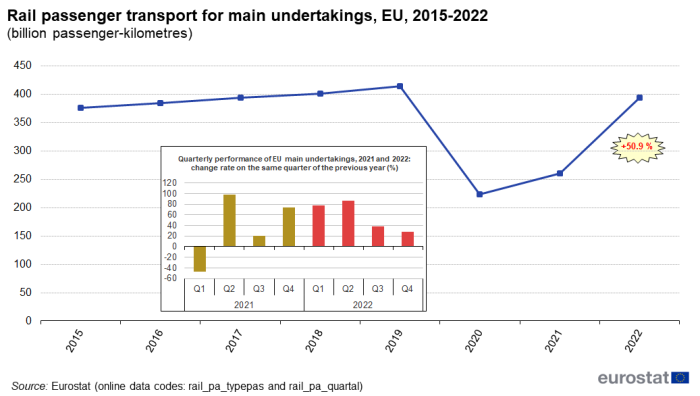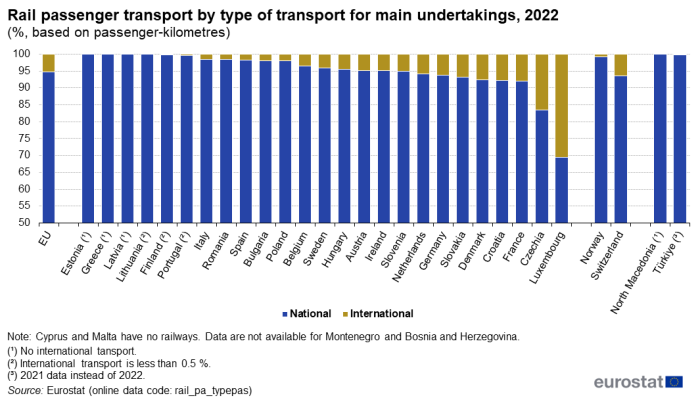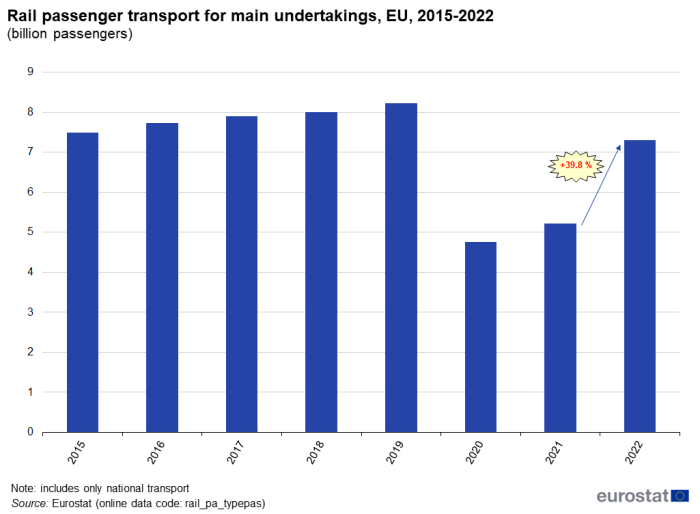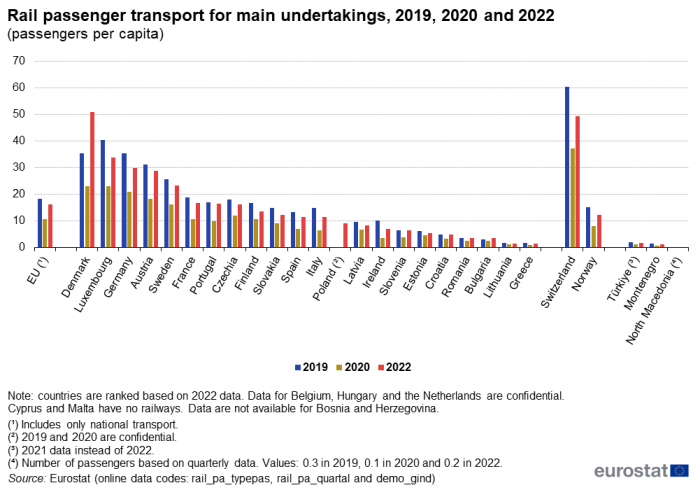Railway passenger transport statistics - quarterly and annual data
Data extracted in November 2023.
Planned article update: 30 November 2024.
Highlights
Rail passenger transport for main undertakings, EU, 2015-2022
This article presents the main trends in rail passenger transport in the European Union (EU), and the EFTA countries Norway and Switzerland as well as the candidate countries Bosnia and Herzegovina, Montenegro, North Macedonia and Türkiye. It covers quarterly and annual rail passenger transport data. This article, together with the article Railway freight transport statistics presents a complete overview of railway transport in Europe.
Full article
In 2022, the EU rail passenger transport performance significantly recovered from the sharp fall in 2020
Between 2015 and 2019, the demand for rail passenger transport steadily increased, leading to an overall 10.2 % increase between 2015 and 2019, when a peak of 414 billion passenger-kilometres (pkm) was registered (see Figure 1). This upward trend was abruptly reversed in 2020 with the spread of the COVID-19 pandemic. As a result of strict precautionary measures and a reduced number of trains in operation since March 2020, rail passenger transport reduced significantly in all EU Member States. Compared with the previous year, rail passenger transport performance almost halved in the EU (-46.0 %) reaching 224 billion pkm.
In 2021 only a partial recovery can be observed, with a 16.6 % increase compared with 2020. However, in 2022, for most European countries, the rail passenger transport offer has already returned to a level close to that of 2019 and for few countries even higher. Overall, rail passenger transport increased by 50.9 % in the EU compared with 2021, reaching a performance of 393 billion pkm. However, this level was still 5 % below the performance levels observed before the pandemic. When looking at the quarterly performance, the first quarter of 2021 was still largely impacted by the remaining COVID-19 precautionary measures, showing a reduction of 47.8 % compared with the first quarter of 2020. The three following quarters of 2021 and all quarters of 2022 recorded again substantial increases (compared with the same quarters of the previous year). The highest growths were recorded in the second quarter of 2021 (+98.3 % compared with 2020), the fourth quarter of 2021 (+73.5 % compared with 2020), the first quarter of 2022 (+77.2 % compared with 2021) and in the second quarter of 2022 (+86.7 % compared with 2021).

(billion passenger-kilometres)
Source: Eurostat (rail_pa_typepas) and (rail_pa_quartal)
France and Germany were the largest contributors to the EU rail passenger transport performance in 2022
In 2022, six EU Member States fully recovered after the massive drop of rail passenger transport performance in 2020 and even surpassed the pre-COVID level (see Figure 2). The highest increase in 2022 compared with 2019 among the EU Member States was recorded by Slovenia (+12.6 %), followed by Croatia (+12.2 %), France and Lithuania (both +6.5 %), Bulgaria (+5.3 %) and Denmark (+3.3 %). The majority of EU Member States have not yet quite reached the levels observed in 2019. The highest decrease in 2022 compared with 2019 among the EU Member States, for which data are available, was observed in Ireland (-27.1 %), followed by Slovakia (-20.0 %), Italy (-17.8 %), Latvia and Luxembourg (both -16.0 %), Czechia (-13.5 %), Portugal (-12.6 %), Sweden (-11.9 %) and Greece (-10.8 %). A similar trend was observed in Norway (-17.1 %), Switzerland (-11.3 %), North Macedonia (-25.5 %) and Montenegro (-22.7 %. When comparing 2022 with 2020, all countries recorded a substantial increase in their rail passenger performance. The highest growths were recorded by Spain, Italy and Ireland. The three countries more than doubled from 2020 to 2022.

(billion passenger-kilometres)
Source: Eurostat (rail_pa_typepas) and (rail_pa_quartal)
In 2022, France and Germany were the largest contributors to the rail passenger transport performance in the EU, with 102.8 billion pkm (or 26.1 % of the EU total rail passenger transport performance) and 92.3 billion pkm (or 23.5 %), respectively. At the other end of the scale, nine EU Member States recorded less than 2 billion pkm in 2022. The candidate countries Bosnia and Herzegovina, Montenegro and North Macedonia recorded less than 60 million pkm in 2022.
From the perspective of the share between national and international transport, national transport is usually predominant. It represented more than 90 % of the total rail passenger transport performance for all EU Member States in 2022, with the exception of Luxembourg and Czechia where national transport represented 69.4 % and 83.4 %, respectively (see Figure 3). Only national passenger transport was reported for 2022 by Estonia, Greece and Latvia.

(%, based on passenger-kilometres)
Source: Eurostat (rail_pa_typepas)
In 2022, Luxembourg and Denmark had the highest numbers of passengers per capita transported by rail
When looking at the number of passengers transported by rail at national level, the situation was similar to the transport performance in passenger-kilometres. Between 2015 and 2019, the number of rail passengers transported steadily increased, leading to an overall 9.9 % increase between 2015 and 2019, when a peak of 8.2 billion passengers were registered (see Figure 4). This upward trend was abruptly reversed in 2020 (-42.2 % compared with 2019), reaching only a total of 4.8 billion passengers. Partial recovery can be observed in 2021 and 2022, reaching 5.2 and 7.3 billion passengers, respectively. Despite an overall 39.8 % increase from 2021 to 2022, this level represents still a 11.2 % decrease compared with the pre-pandemic year 2019.

(billion passengers)
Source: Eurostat (rail_pa_typepas)
With the exception of four EU Member States, all countries reported reductions in the number of passengers transported by rail in 2022 (see Figure 5) compared with 2019. The largest decrease was recorded in Ireland, by 28.4 %, followed by Italy (-22.8 %), Greece (-21.3 %), Finland (-18.0 %), Slovakia (-17.3 %), Latvia (-15.7 %), Estonia (-14.9 %), Germany (-14.7 %), Luxembourg (-11.9 %), Spain (-11.7 %) and Lithuania (-10.6 %). By contrast, four EU Member States recorded growths in 2022 compared with 2019. The highest rebound among the EU Member States was recorded by Denmark (+46.0 %). This phenomenon can be mainly attributed to an increase in the number of companies offering international rail passenger services. Increases in passengers transported, albeit at a lower level, can also be observed in Bulgaria (+8.1 %), Slovenia (+4.9 %) and Romania (+2.1 %). It should be noted that France, Croatia and Lithuania recorded decreases in the number of passengers transported by rail in 2022 compared with 2019 while they reported increases in the rail transport performance in passenger-kilometres. Conversely, Romania reported an increase in the number of passengers transported by rail in 2022 while a decrease was recorded in the rail transport performance.

(million passengers)
Source: Eurostat (rail_pa_typepas) and (rail_pa_quartal)
Regarding the number of passengers transported by rail, Germany was by far the largest contributor in the EU, recording 2.5 billion passengers (or 34 % of the EU total) in 2022. France, Italy and Spain followed with 1.1, 0.7 and 0.6 billion passengers, respectively. At the other end of the scale, Lithuania and Estonia registered less than 8 million passengers in 2022. In the candidate countries Bosnia and Herzegovina, Montenegro and North Macedonia, less than one million passengers were recorded in 2022.
Figure 6 presents the number of passengers transported in relation to the population of the reporting countries. At EU-level, an average of 16.3 passengers per capita travelled by rail within their country in 2022, increasing by 5.7 passengers per capita compared with 2020, but dropping by 2.1 passengers per capita compared with 2019. Denmark and Luxembourg had the highest rates in 2022, with 51.1 and 33.7 passengers per capita, respectively. The EFTA country Switzerland also registered a high rate, with 49.4 passengers per capita. In 2019, Switzerland’s rate was even higher, with 60.6 passengers per capita. Germany, Austria and Sweden were the other EU Member States with more than 20 passengers per capita (29.9, 28.9 and 23.3, respectively). For seven EU Member States, the rate stood between 17 and 11 passengers per capita, for five others between nine and five passengers per capita, and another five countries had a rate between five and one passengers per capita. Greece registered the lowest rate with 1.5 rail passengers per capita in 2022. The candidate country North Macedonia recorded even less than 1 passenger per capita transported by rail in 2022.
When comparing the rates of 2022 with 2019, increases were observed for four EU Member States. The most significant increase was recorded by Denmark (+15.6 passengers per capita).

(passengers per capita)
Source: Eurostat (rail_pa_typepas) and (rail_pa_quartal)
Source data for tables and graphs
Data sources
The figures presented in this article have been extracted from the Eurostat rail transport database. They include data on national, international and transit transport of the Member States, EFTA, candidate countries and potential candidates, collected according to the Regulation (EU) No 2018/643 - recast of Regulation (EU) No 2016/2032. The transport of passengers by metro, tram and/or light rail is excluded. The data presented are included in Eurostat’s dissemination database (reference tables are provided under each table and graph). There are no railways in Cyprus, Malta and Iceland. The various elements present data collected under the detailed reporting system, meaning that data include only main undertakings which are defined as follows:
- Until 2015: undertakings with a total transport performance greater than 500 million tonne-km or 200 million passenger-km.
- From 2016: undertakings with a total volume of goods transport of at least 200 million tonne-km or at least 500 000 tonnes or total volume of passenger transport of at least 100 million passenger-km.
Railway undertakings which are below the thresholds may however be included for some countries. Basic results and derived indicators (such as growth rates and shares in percentage of total) in the tables are rounded. However, the figures are based on the non-rounded original data. As a result, the sum of shares in percentage of total, as shown in the tables, is not necessarily equal to 100 %.
Due to confidentiality, the EU aggregate for passenger transport by rail cannot be disclosed for years before 2015. That is why the data series presented in this article start in 2015 and not in 2012 as in the article Railway freight transport statistics.
Explanatory notes for countries are available in the metadata on the Eurostat website.
Context
The content of this statistical article is based on data collected within the framework of Regulation (EU) No 2018/643 recast of Regulation (EU) No 2016/2032.
Direct access to
- Transport, see:
- Railway transport (t_rail)
- Rail transport of passengers (ttr00015)
- Transport, see:
- Railway transport (rail)
- Railway transport measurement - passengers (rail_pa)